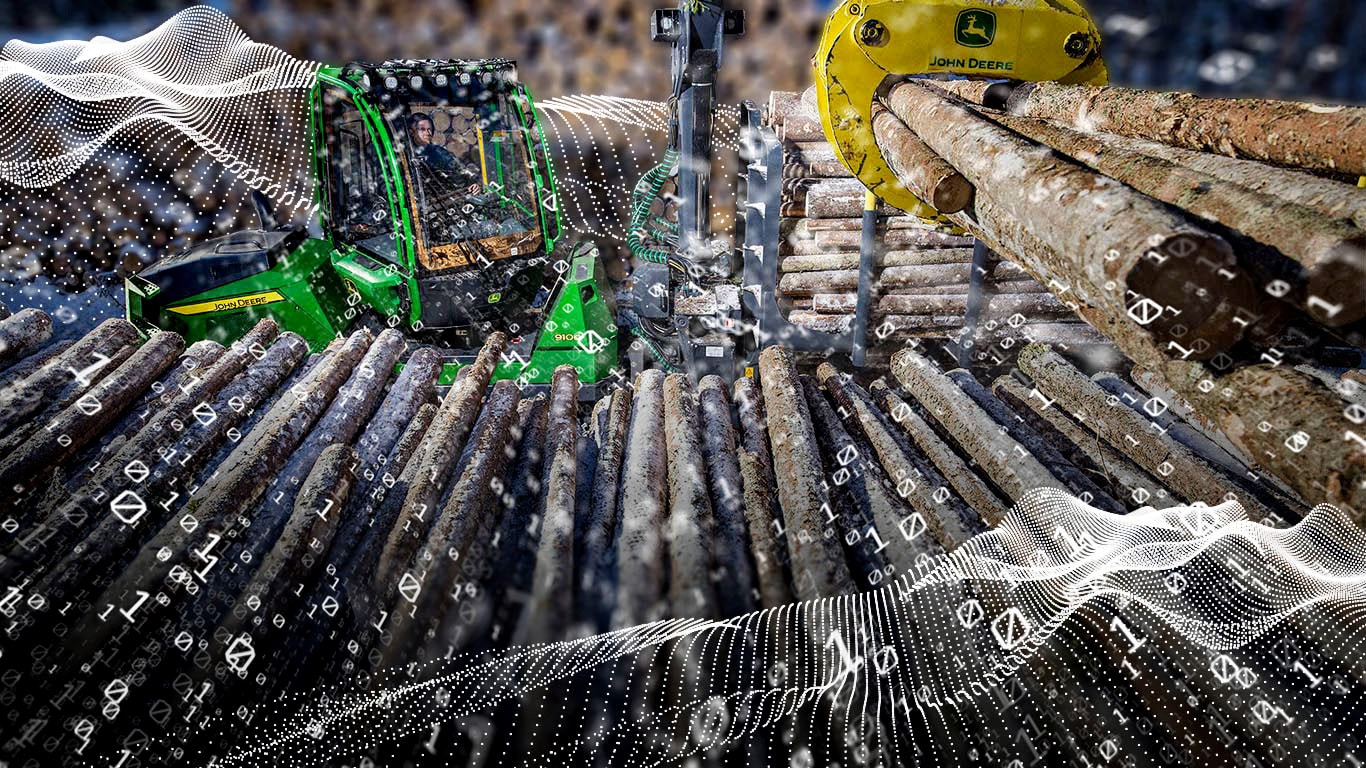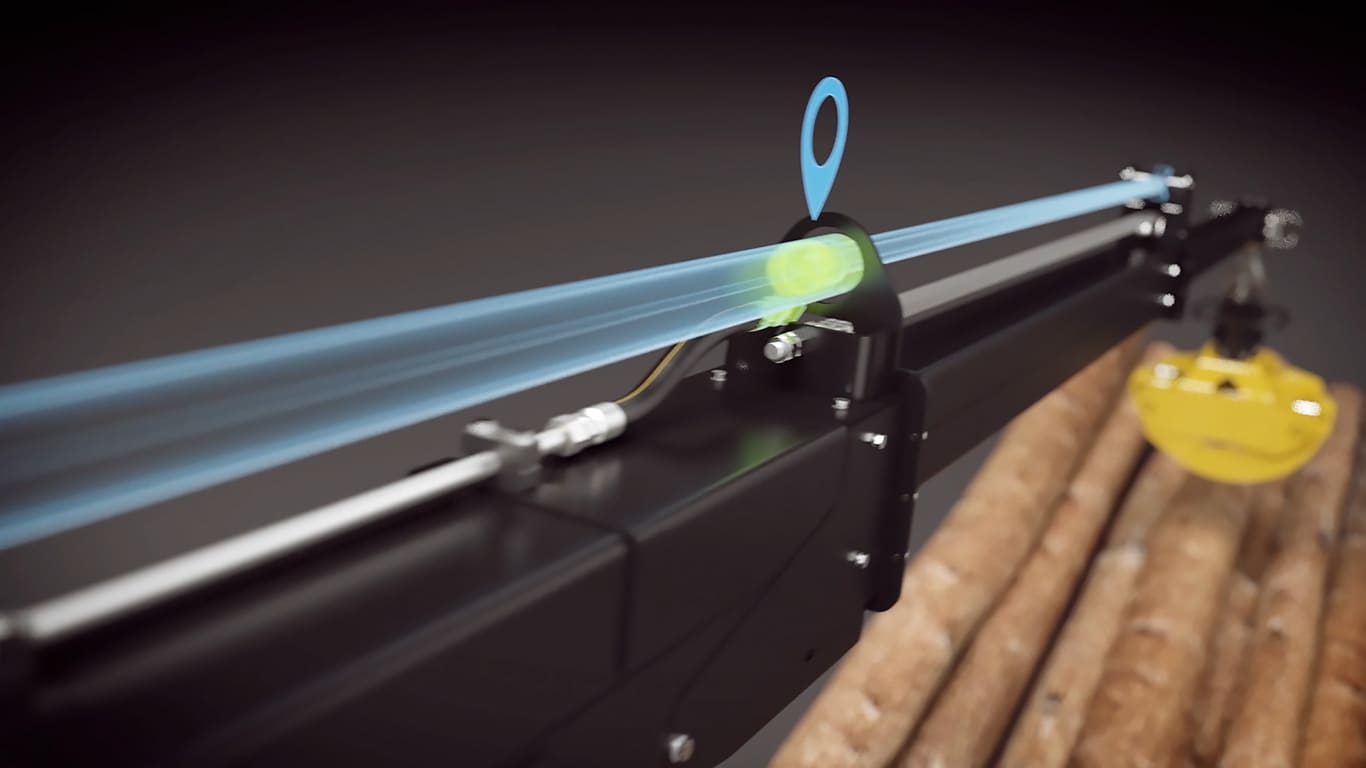Maintenance and Support
You May Also Be Interested In
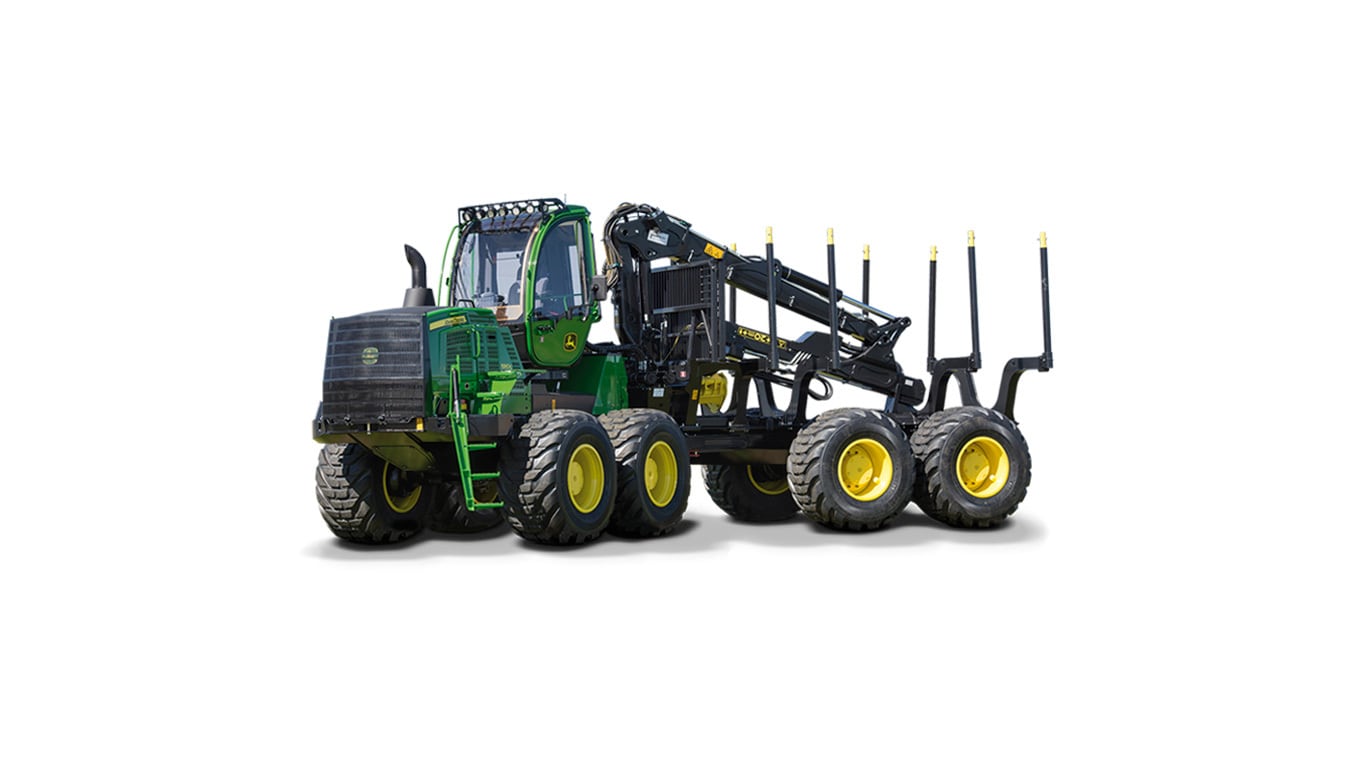
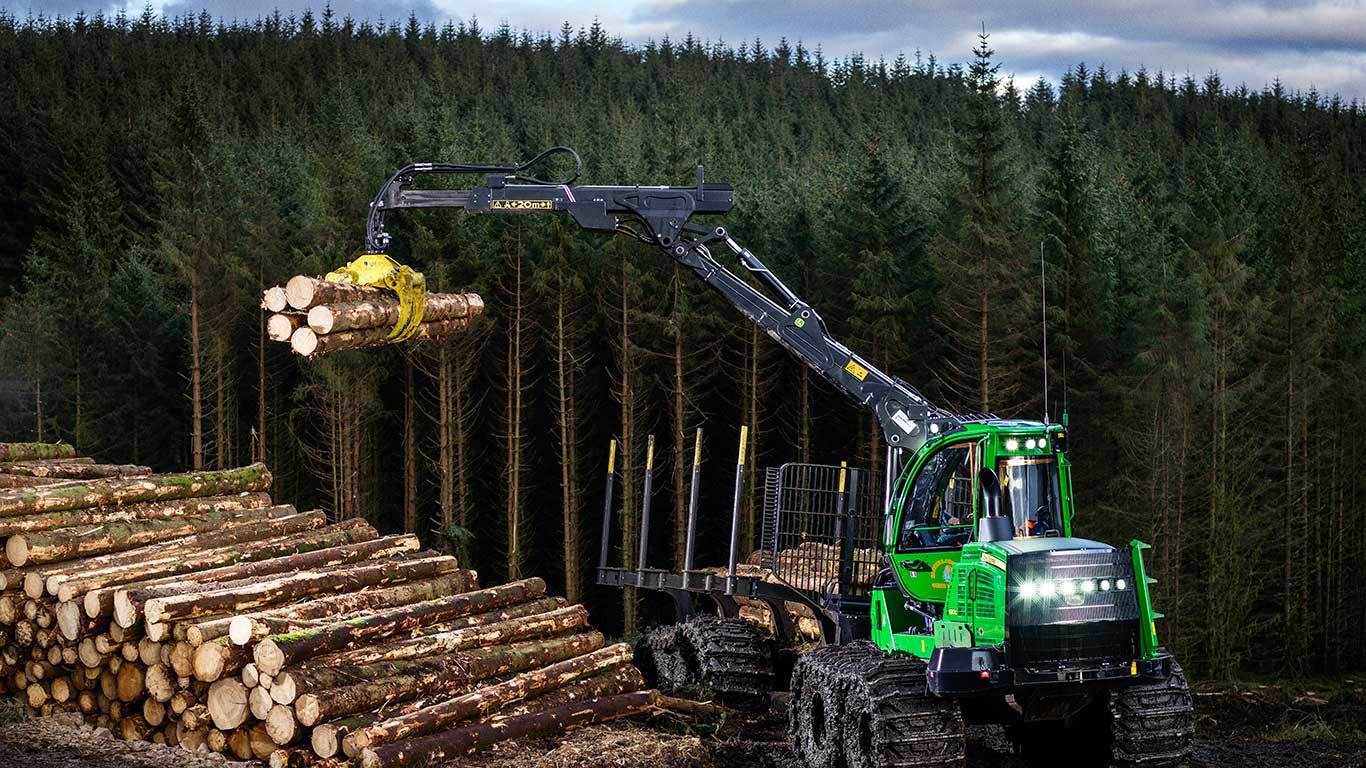
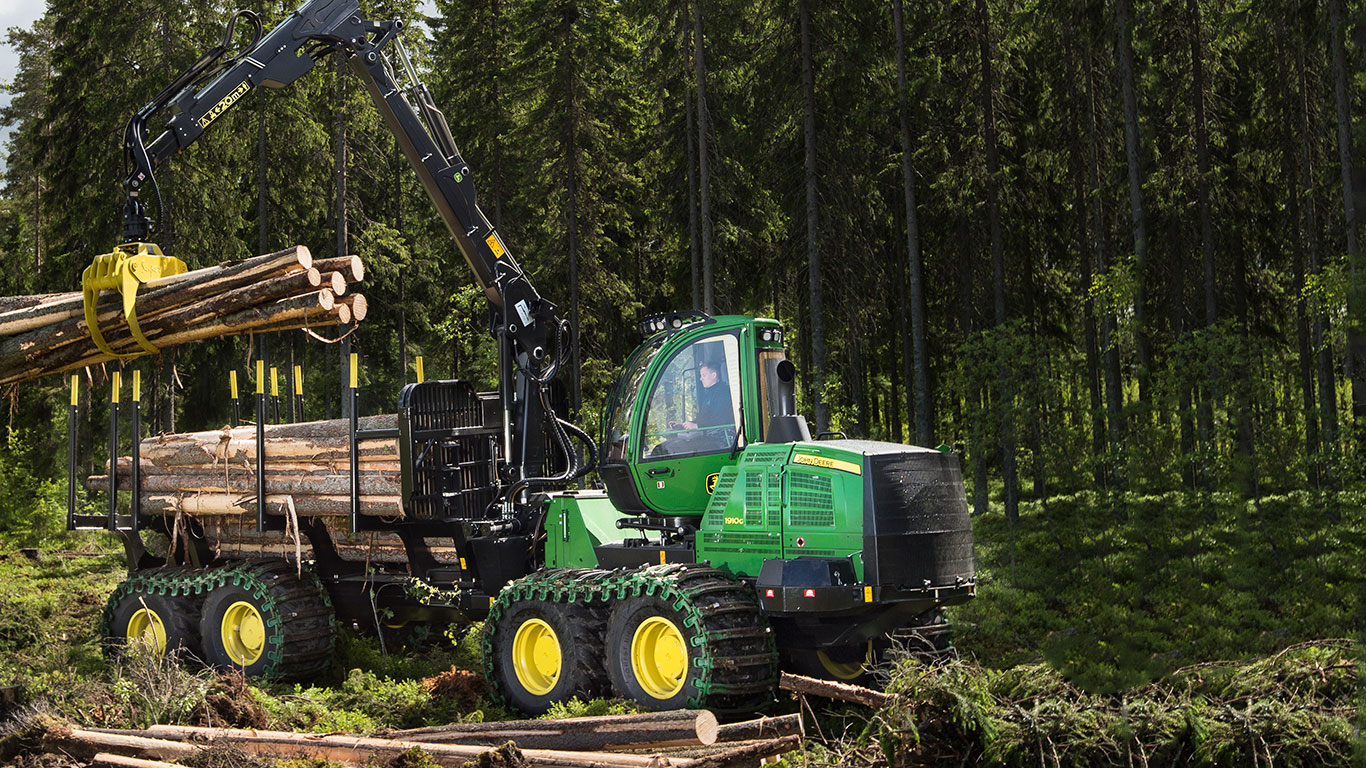
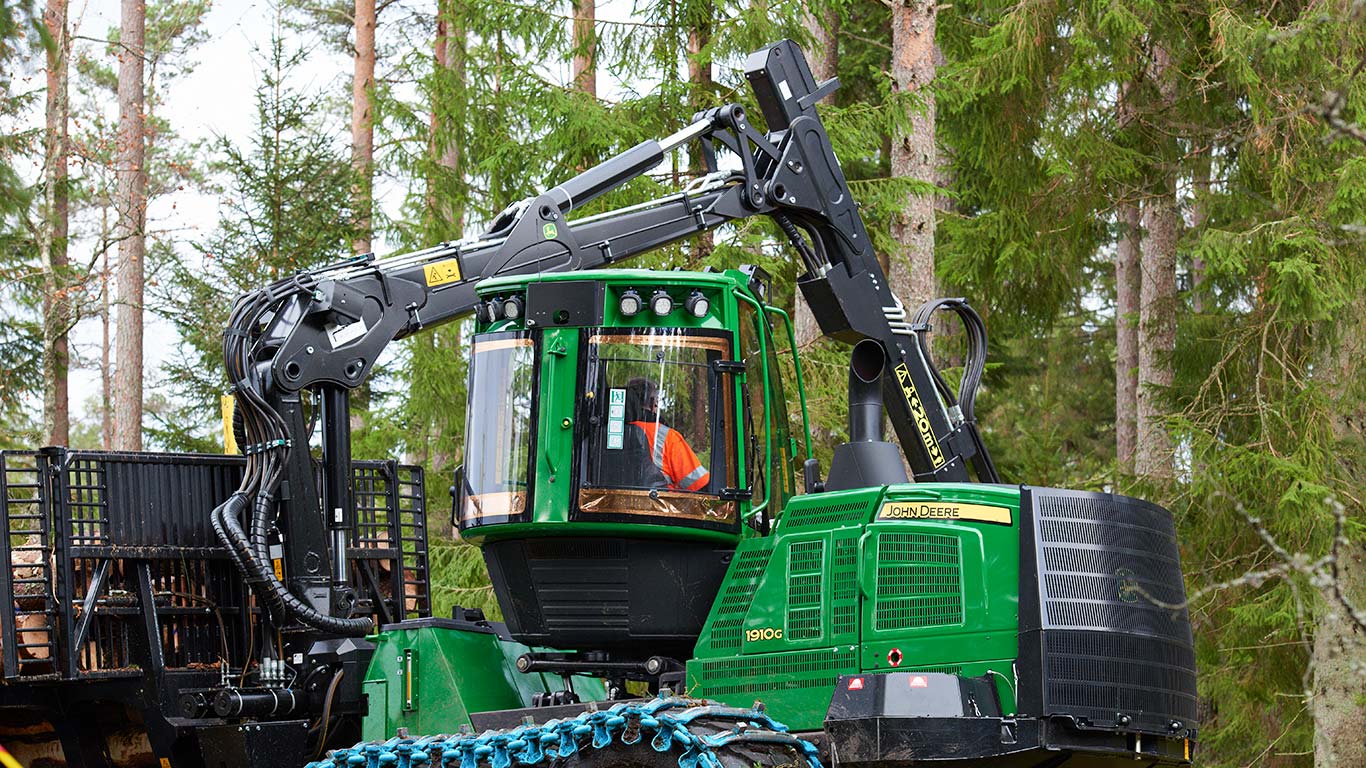




1910G Forwarders
- Best for large loads in difficult terrain
- Working is easy even on steep slopes
- Levelling cabin keeps the operator upright
- Fast loading and good visibility to the load space
Exact location of each log
The data between the machines are updated through a cloud service, and all the operators working at the same work site can see all the tree species and assortments with the driving routes right down to the individual logs.
Timber in good order
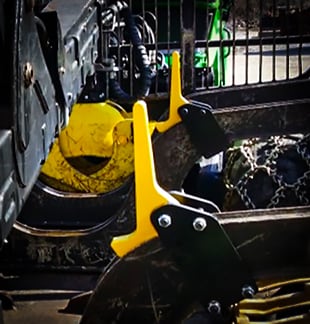
Sorters make it easy to sort the timber in the forwarder’s load area. Sorters are easy to use. The tiltable sorters can be quickly tilted with the grapple. The sorters stand about 20 cm high when vertical and about 10 cm when tilted.
With TimberMatic Maps, the different assortments can be highlighted with different colors by marking them as favourites. This together with the sorters, helps to separate the assortments and to build the load already sorted which speeds up the unloading considerably.
Specifications
Collapse All
Expand All
1910G
| Engine |
|
| Tractive force | 230 kN |
| Load rating | 19 000 kg |
| Load space |
|
| Cabin | Fixed or rotating and leveling |
| Boom |
|
| Control system | TimberMatic |
| Weight with fixed cabin from |
|
| Length | 10 570 / 11 470 mm |
| Width, min. | 3090 mm |
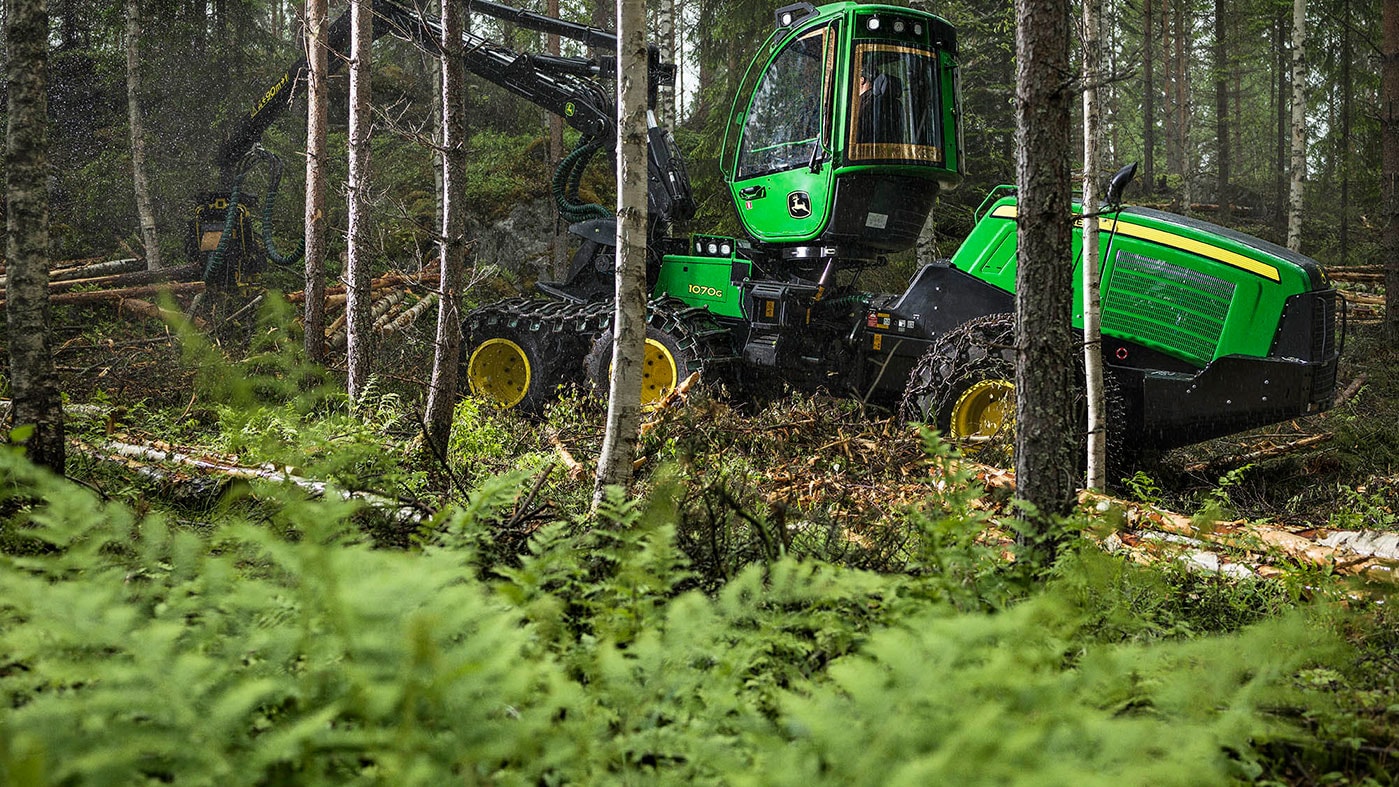
Product program
Product Program wheeled cut-to-length
Electrical cylinder end damping
The Intelligent Boom Control features electrical end damping for all the main boom movement directions. The system dampens the cylinder end movements softly and stops strong blow-like loads in the end positions.
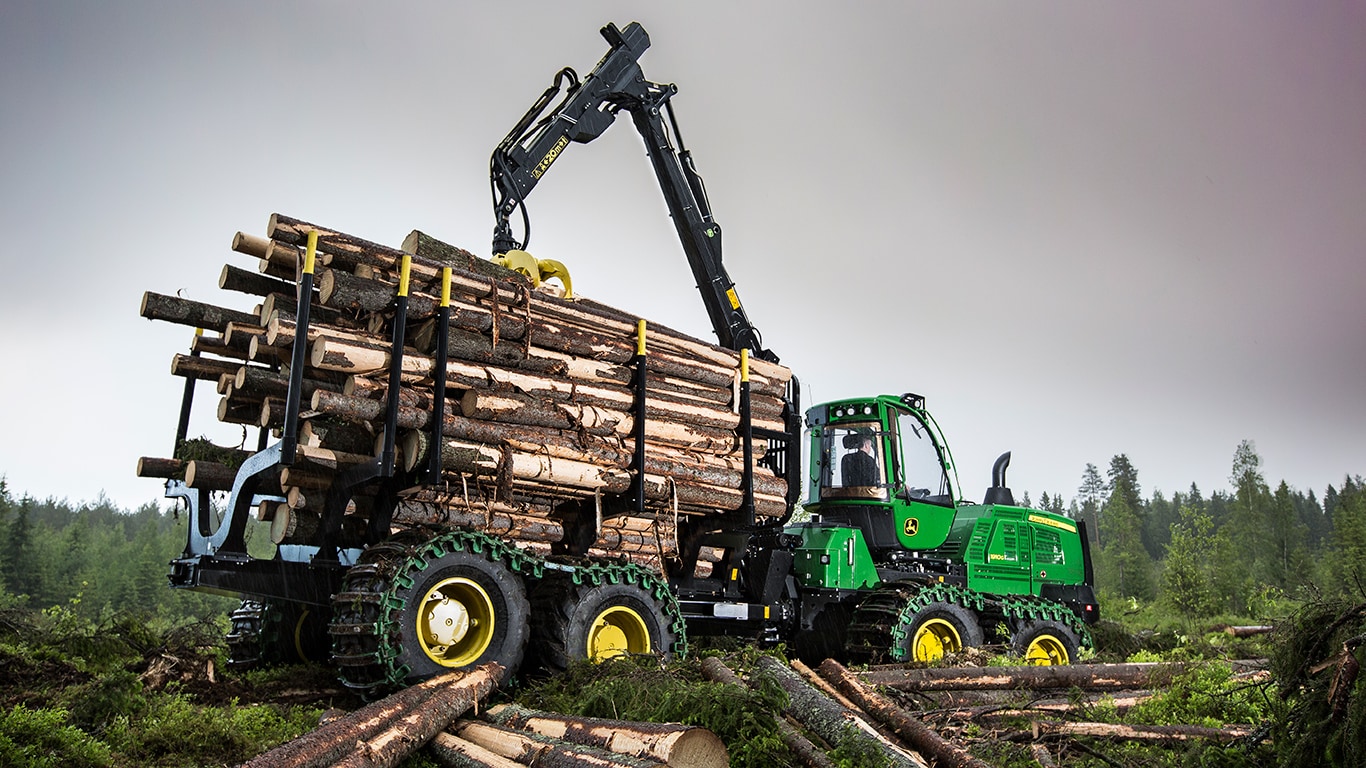
XI-boom with 10 m reach
The main features of 1910G are high power and load capacity. When a long reach is required, the machine can be equipped with CF7S XI Power+ 10 m boom. The load area is 6.5m2 at its widest and the headboard provides excellent visibility to the load space.
Features
Collapse All
Expand All
Intelligent boom control IBC
The IBC (Intelligent Boom Control) option is a milestone in forest machine technology. The boom is accurate and easy to operate: the operator controls the boom tip directly instead of controlling independent boom joint movements. The system also considerably reduces the number of tuning parameters needed and increases durability of boom structures and hydraulic cylinders.
Boom functions as one
The IBC system enables you to control the entire loader as one unit and you no longer need to learn to control several different boom movements together. Controlling the grapple is similar to controlling the movements of your own hand. The IBC system guides the boom wherever the operator wants to take the grapple. The system has predefined limit values and it adjusts boom operations within these limits according to need. In the 2.0 version of intelligent boom control, the precision of the grapple control has been improved, especially in long reaches. The software uses information about the grapple position, and the speed of the rotation in long reaches matches that of short reaches.
IBC system also has a separate, preprogrammed option for unloading, where the strong jib and main boom movements are used more.
Electrical cylinder end damping
The IBC system also features electrical end damping for all the main boom movement directions. The system dampens the cylinder end movements softly and stops strong blow-like loads in the end positions which makes driving smoother and also improves the durability of the boom.
Operator adjustments
Operators can adjust the overall speed of the IBC system according to their needs. They can also adjust the speed between various boom parts or change it by using the extension boom manually during operation. The system is switched on and off with the press of a button.
Adaptive Driveline Control
Adaptive driveline control is a unique standard feature in G-Series machines. This control system improves the machines’ drivability and productivity. The operator selects the desired driving mode (Eco, Normal, Power) for the operating conditions, and the system automatically adjusts the engine’s RPMs to correspond with the engine load and keeps the driving speed steady also during high loads.
The driveline control ensures that the diesel engine runs smoothly and uses the available maximum tractive force efficiently during high-load situations. Also the response of the drive pedal and frame steering have been improved with smart electronic filtering.
Load space
The cross-sectional area of the 1910G load space is 6.5 m2 at its widest. The cross-sectional area of the narrow load space is 5.3 m2. The new-generation headboard provides good visibility to the load space, facilitating the unloading process in particular.
In addition to narrow and wide load space, Variable Load Space (VLS) is optional. The variable VLS load space consists of 4 telescopic bunks and a headboard. The bunks can be extended and contracted hydraulically and the headboard expands automatically with the bunks. The headboard can also be expanded horizontally and vertically independent of the bunks. The load space width can be adjusted between 3,0 to 3,6 m and the cross-sectional area between 5,4 to 6,8 m2. VLS load space option is available for both load space lengths, short and long.
A rotating and leveling or a fixed cabin
Cabin comfort is a productivity factor. The cabin of a John Deere forest machine is a comfortable and ergonomic work environment. The cabin is available as fixed or rotating and levelling version.
The levelling and rotating cabin helps the operator to maintain the correct working posture to prevent stress on the back and shoulder areas. The operator can sit upright even on uneven terrain, and the cabin can be rotated in all directions to face the work area. The cabin has more legroom in front and the seat has two different height settings. The proven and efficient vibration absorption improves the working conditions further. Leveling and rotating functions are an option in harvesters. The cabin is fixed if these options are not chosen.
Fixed cabin for forwarders is a completely different structure. One advantage of the fixed cabin for forwarders is the low centre of gravity, which provides a steady feel to the seat. The big windows offer good visibility in every direction and also close to the machine and its tires. The cabin has rubber mountings that dampen vibration. The noise level in the fixed cabin for forwarders is low and matches that of the leveling and rotating cabin.
For meal breaks, the cabins feature a mini oven and refrigerator.
The cabin’s interior materials were chosen with ease of cleaning in mind. The leather-like material on the interior pillars is easy to clean. The neoprene wiper blades are more durable than natural rubber blades.
The ergonomic seat, air conditioning and heating, sun visors and sun blinds, and side widow wipers add to cabin comfort. Plenty of light is needed during dark hours, so the positioning of the lights has been continuously improved to enhance visibility during the autumn and winter.
Control systems and automation
The TimberMatic control system and user interface on G-Series forwarders have been developed and improved to maintain the forest machine’s operational reliability. The TimberMatic features a configurable user interface, cruise control and inclination display. The new software version enables Remote Display Access (RDA) via the Internet (either MTG or other modem). RDA enables faster troubleshooting by servicing people and thus improves the machine’s uptime.
Forwarders have three control modules: for the cabin, the front frame and the rear frame. TimberMatic’s troubleshooting diagnostics are more detailed and illustrative. The CAN bus increases reliability of the electrical system: simple, fewer connections, a dedicated bus for the engine and the base machine.
TimberMatic Maps is standard in all new John Deere forest machines. Based on the real time data from Maps to TimberManager, distributed through a cloud service, the contractor can follow up forest machine’s production and remaining work on the site and plan the operations further.
Hydraulics
Hydrostatic pump and motor for transmission
The hydraulic components of the transmission in the John Deere 1910G forwarder are bigger than in previous models, so the average pressure level remains lower and the components have a longer lifetime. The number of pistons was increased from 7 to 9, further improving the machine’s performance in extreme terrain conditions. The more robust components of the pump, the engine and the bearings bring increased durability and reliability.
Boosting hydraulic efficiency also results in less fuel consumption. System reliability has been improved by reducing the number of sealing points.
Together with the engine’s wider torque area, the revamped transmission improves the forwarder’s driving performance, drivability and fuel economy.
FT4 engine
John Deere Final Tier 4 engines meet the required emissions regulations while also bringing more power and torque. The output of the John Deere 6090 PowerTech Plus engine in 1910G forwarder (200 kW) is 7.5% and torque (1315 Nm) even 21% more than in the T3 engine in 1910E.
Especially the low rpm ranges have much more torque than the E-models. The John Deere FT4 engine has the most torque in its class and a wide rpm range. The engine’s rpm remain steady during big and rapid changes in the load.
Even with the increased power, John Deere’s FT4 engine is very fuel efficient.
The FT4 engine and the entire fuel line can use 20% biodiesel.
Features
Collapse All
Expand All
Intelligent boom control
The IBC (Intelligent Boom Control) option is a milestone in forest machine technology. The boom is accurate and easy to operate: the operator controls the boom tip directly instead of controlling independent boom joint movements. The system also considerably reduces the number of tuning parameters needed and increases durability of boom structures and hydraulic cylinders.
Boom functions as one
The IBC system enables you to control the entire loader as one unit and you no longer need to learn to control several different boom movements together. Controlling the grapple is similar to controlling the movements of your own hand. The IBC system guides the boom wherever the operator wants to take the grapple. The system has predefined limit values and it adjusts boom operations within these limits according to need. In the latest 2.0 version of intelligent boom control, the precision of the grapple control has been improved, especially in long reaches. The software uses information about the grapple position, and the speed of the rotation in long reaches matches that of short reaches.
IBC system also has a separate, preprogrammed option for unloading, where the strong jib and main boom movements are used more.
Electrical cylinder end damping
The IBC system also features electrical end damping for all the main boom movement directions. The system dampens the cylinder end movements softly and stops strong blow-like loads in the end positions which makes driving smoother and also improves the durability of the boom.
Operator adjustments
Operators can adjust the overall speed of the IBC system according to their needs. They can also adjust the speed between various boom parts or change it by using the extension boom manually during operation. The system is switched on and off with the press of a button.
Adaptive Driveline Control
Adaptive driveline control is a unique standard feature in G-Series machines. This control system improves the machines’ drivability and productivity. The operator selects the desired driving mode (Eco, Normal, Power) for the operating conditions, and the system automatically adjusts the engine’s RPMs to correspond with the engine load and keeps the driving speed steady also during high loads. The driveline control ensures that the diesel engine runs smoothly and uses the available maximum tractive force efficiently during high-load situations. Also the response of the drive pedal and frame steering have been improved with smart electronic filtering.
Load space
The cross-sectional area of the 1910G load space is 6.5 m2 at its widest. The cross-sectional area of the narrow load space is 5.3 m2. The new-generation headboard provides good visibility to the load space, facilitating the unloading process in particular.
In addition to narrow and wide load space, Variable Load Space (VLS) is optional. The variable VLS load space consists of 4 telescopic bunks and a headboard. The bunks can be extended and contracted hydraulically and the headboard expands automatically with the bunks. The headboard can also be expanded horizontally and vertically independent of the bunks. The load space width can be adjusted between 3,0 to 3,6 m and the cross-sectional area between 5,4 to 6,8 m2. VLS load space option is available for both load space lengths, short and long.
A rotating and leveling or a fixed cabin
Cabin comfort is a productivity factor. The cabin of a John Deere forest machine is a comfortable and ergonomic work environment. The cabin is available as fixed or rotating and levelling version.
The levelling and rotating cabin helps the operator to maintain the correct working posture to prevent stress on the back and shoulder areas. The operator can sit upright even on uneven terrain, and the cabin can be rotated in all directions to face the work area. The cabin has more legroom in front and the seat has two different height settings. The proven and efficient vibration absorption improves the working conditions further. Leveling and rotating functions are an option in harvesters. The cabin is fixed if these options are not chosen.
Fixed cabin for forwarders is a completely different structure. One advantage of the fixed cabin for forwarders is the low centre of gravity, which provides a steady feel to the seat. The big windows offer good visibility in every direction and also close to the machine and its tires. The cabin has rubber mountings that dampen vibration. The noise level in the fixed cabin for forwarders is low and matches that of the leveling and rotating cabin.
For meal breaks, the cabins feature a mini oven and refrigerator.
The cabin’s interior materials were chosen with ease of cleaning in mind. The leather-like material on the interior pillars is easy to clean. The neoprene wiper blades are more durable than natural rubber blades.
The ergonomic seat, air conditioning and heating, sun visors and sun blinds, and side widow wipers add to cabin comfort. Plenty of light is needed during dark hours, so the positioning of the lights has been continuously improved to enhance visibility during the autumn and winter.
Control systems and automation
The TimberMatic control system and user interface on G-Series forwarders have been further developed and improved to maintain the forest machine’s operational reliability. The TimberMatic features a configurable user interface, cruise control and inclination display. The new software version enables Remote Display Access (RDA) via the Internet (either MTG or other modem). RDA enables faster troubleshooting by servicing people and thus improves the machine’s uptime.
Forwarders have three control modules: for the cabin, the front frame and the rear frame. TimberMatic’s troubleshooting diagnostics are more detailed and illustrative. The CAN bus increases reliability of the electrical system: simple, fewer connections, a dedicated bus for the engine and the base machine.
TimberMatic Maps is standard in all new John Deere forest machines. Based on the real time data from Maps to TimberManager, distributed through a cloud service, the contractor can follow up forest machine’s production and remaining work on the site and plan the operations further.
Hydraulics
Hydrostatic pump and motor for transmission
The hydraulic components of the transmission in the John Deere 1910G forwarder are bigger than in previous models, so the average pressure level remains lower and the components have a longer lifetime. The number of pistons was increased from 7 to 9, further improving the machine’s performance in extreme terrain conditions. The more robust components of the pump, the engine and the bearings bring increased durability and reliability.
Boosting hydraulic efficiency also results in less fuel consumption. System reliability has been improved by reducing the number of sealing points.
Together with the engine’s wider torque area, the revamped transmission improves the forwarder’s driving performance, drivability and fuel economy.
FT4 engine
John Deere Final Tier 4 engines meet the required emissions regulations while also bringing more power and torque. The output of the John Deere 6090 PowerTech Plus engine in 1910G forwarder (200 kW) is 7.5% and torque (1315 Nm) even 21% more than in the T3 engine in 1910E.
Especially the low rpm ranges have much more torque than the E-models. The John Deere FT4 engine has the most torque in its class and a wide rpm range. The engine’s rpm remain steady during big and rapid changes in the load.
Even with the increased power, John Deere’s FT4 engine is very fuel efficient.
The FT4 engine and the entire fuel line can use 20% biodiesel.

